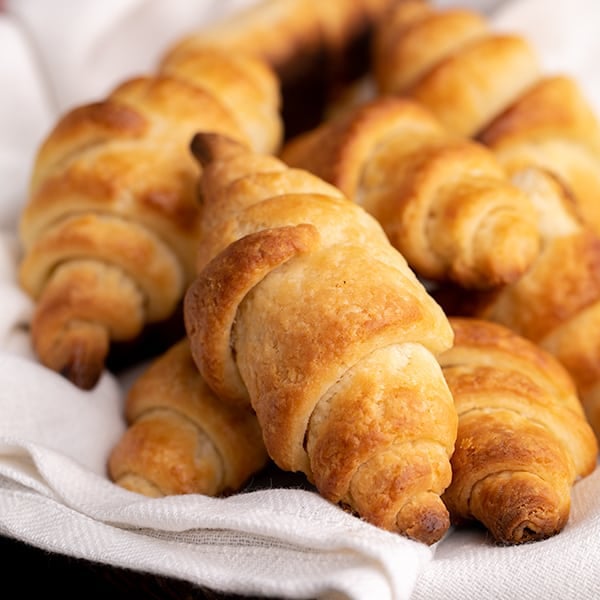

If you have ever wondered if you could make a gluten free croissant at home—whether you could really do it—this recipe is the proof that you can do it. You should do it. Here's how, step by step.

WANT TO SAVE THIS RECIPE?
The best gluten free croissant you'll ever make
These croissants have that melt-in-your-mouth flakiness that seems intimidating, but they’re actually quite simple to make. The amount of information in the recipe card and the step-by-step photos here is not because it’s hard to make these beautiful pastries happen. It’s because it can be hard to imagine what it's like to make them, but once you see it done and the concept clicks, they're really simple to make (although they do take some time).
Believe it or not, traditional gluten free croissants are one of the most common recipes requests I have received over all the years of writing this blog. It’s not like it’s every day that I’m positively buried with requests from readers simply dying to make their own croissants, though.
It’s more like a steady drip-drip-drip of requests over the years. Over time I’ve mostly pointed readers in the direction of an old custard-filled danish recipe from years ago, since danishes are made from yeasted puff pastry, which is really what croissant dough is.
I’ve also suggested to readers that they just use my recipe for gluten free puff pastry (no yeast involved), and call it a day. After all, that's a delicious recipe that makes really flaky gf pastries.

The secret to making a perfect gluten free croissant
Traditional croissants are, indeed, made with what is essentially a yeasted puff pastry dough, making these the most delicate and flaky of pastries as they get lift both from yeast and from “laminated” dough (lamination is simply the process by which you encase layer after layer of cold butter in layer after layer of pastry dough). That’s the only time you’ll hear any “fancy” terms, though, in this whole business. Period full stop.
Read through the instructions below, stare at the step-by-step photos, and watch the video. Follow the temperature instructions to the letter (sometimes ingredients and doughs are room temperature, sometimes (usually) they’re cold), and remember that pastry dough is much less a matter of chemistry than it is a matter of architecture.
Layers and layers of butter surrounded by layers and layers of gluten free flour. The yeast gives these an extra lift over puff pastry, but really the general puff pastry architecture is what does the heavy-lifting of creating the flakiness we crave.
Think of it like this: unlike flour, butter expands as it warms. When the butter layers (created in the “turns” described below) are properly chilled, they hit the heat of the oven and puff up, forcing the flour layers up and out.

Gluten free croissant ingredients
- Gluten free pastry flour – For this easy gluten free croissant recipe, you need a pastry flour, which you can easily make yourself by combining Better Batter all purpose flour, cornstarch, and dry milk.
- Instant yeast – Yeast is what distinguishes gluten free croissant dough from pastry dough. During a proofing period, it causes your croissants to puff up, revealing all those amazing layers. Here, we use instant yeast, since it doesn't have to be hydrated in liquid first, but can be whisked right into the dry ingredients. If you only have active dry yeast, you'll need 25% more of it, by weight, and to let it proof first in some of the milk.
- Sugar – There's only a little sugar in this gluten free croissant recipe to “feed” the yeast.
- Salt – Salt is a must to complement the intense buttery flavor, and to control the yeast.
- Butter – This is the star of the show. It's what gives you that incredible flavor and mouthfeel, but as the gf croissants bakes, it's also what releases steam for maximum flakiness.
- Milk – This is the liquid that brings the gluten free croissant dough together.
- Eggs – We only need one egg for this gf croissant recipe, to brush on before baking, so you can achieve a rich, golden brown crust.
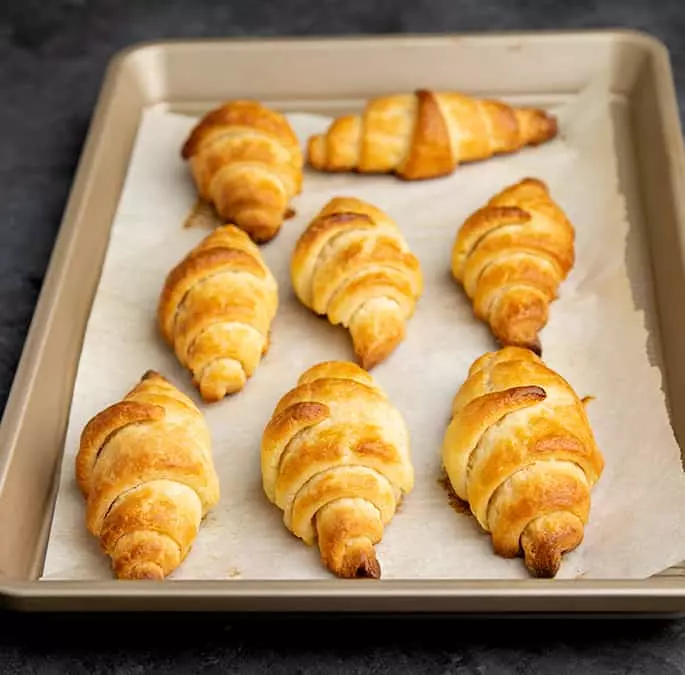
Equipment you need
- Large mixing bowl
- Rolling pin
- Parchment paper
- Plastic wrap
- Pastry cutter or pizza cutter
- Baking sheets
- Basting brush
Gluten free croissants vs. gluten free crescent rolls
Be honest: Have you been using the words croissant and crescent roll interchangeably? It's okay if you have, as many people do in the gluten free baking world (and the world at large).
The baked goods do look similar, both being shaped into a crescent after having been rolled. But there's a huge difference when it comes to preparation and ultimately taste and texture.
Gluten free crescent rolls are made using a gluten free bread flour blend that you roll out and shape. Compared to making croissants, a gluten free crescent roll recipe is a very quick and simple affair.
GF croissants take more time and effort because you laminate the dough, or fold in a butter packet with multiple folds to create flaky layers. You also use a pastry flour blend that contains dry milk.

Tips for making gluten free croissants
Don't try to rush the process
Look, I will just come right out and say that making gf croissants isn't the kind of task that you take up on a busy Friday night when you're in a rush to get dinner on the table. It's not even the kind of thing that you do on a slow Wednesday afternoon when you have an hour to burn.
It's takes time to make gluten free croissants, and if you try to rush the process — say, by skipping the several refrigeration steps or reducing the number of turns — you're not going to end up with the same buttery, flaky goodness you see in all these pictures.
The first time you decide to make gluten free croissant rolls, set aside a weekend. Give yourself plenty of time to get familiar with the preparation steps and practice, practice, practice. It's the only way you'll build the confidence and skill to do these right.
Splurge on the butter packet
I would argue that the butter packet is the star of this show. And because you don't need a ton of it (despite the fact that it adds the most flavor), it's the perfect place to splurge when buying ingredients.
If you can swing it, I highly suggest trying a European-style butter. Overseas, butter is made with more fat, so it's so incredibly rich and flavorful.
Shaping gluten free croissants
These gluten free croissants look really fancy, but I promise that getting them into that shape isn't nearly as hard as it looks.
Once you've rolled out your dough a final time, you cut out equally sized rectangles. Then you slice those rectangles diagonally to create long triangles.
I suggest using a pastry wheel for this step, but a pizza cutter or sharp knife will work too. You need a sharp tool as crisp lines help maintain definition.
All that's left to do now is put a small slit at the widest part of the triangle, and then roll the croissants up from the base, just slightly turning the edges away from each other as you go.
Don't hesitate to use the refrigerator
Butter is the star of the show, and although we begin working with it while it's cold, we have to work with solid at room temperature, using our hands. The heat from the room and the heat of our hands does tend to warm the butter and cause it to begin to melt. That's why the process calls for handling the butter and the dough, and then refrigerating it until it's solid again before proceeding.
There may be times when you notice signs that the butter is melting. The dough may become sticky or difficult to handle. Even if the recipe doesn't call for refrigeration at any particular time, don't hesitate to refrigerate the dough whenever you need and just pick up where you left off once it's chilled.
To keep the dough from drying out if you leave it in the refrigerator for more than a few minutes, just wrap it with plastic wrap. It doesn't need to be wrapped tightly, though, unless you are leaving it for an extended period of time.
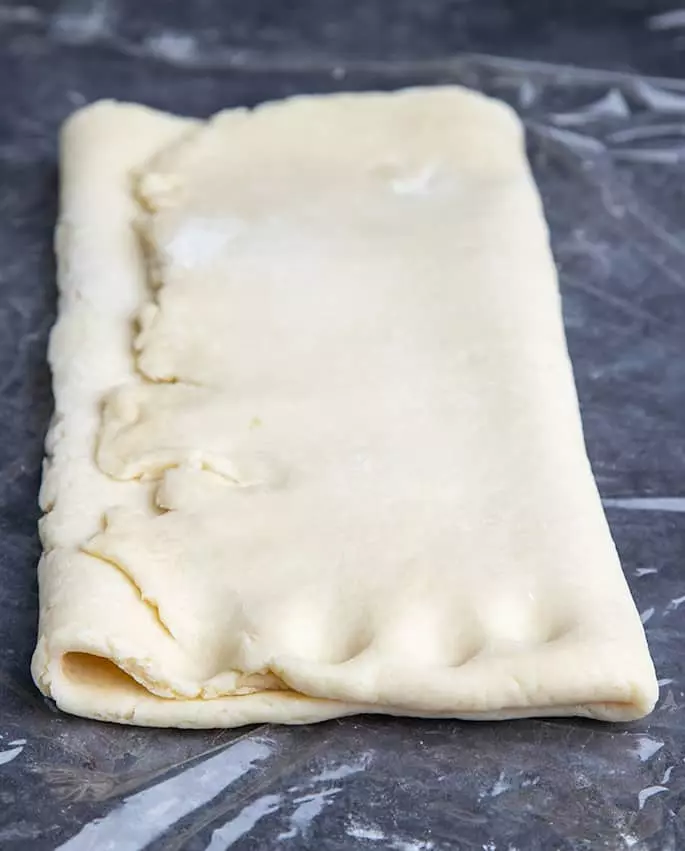
How to store gluten free croissants so they stay fresh
Baked gluten free croissants can sit at room temperature in an airtight container, and they'll stay fresh for two to three days.
Note that the longer they sit, the more they'll harden and go stale. If you get to that point, you can quickly refresh a gluten free croissant to restore softness by popping it into the microwave for 10 to 15 seconds.
Can I freeze baked gluten free croissants?
Absolutely! If you've made too many or are simply meal planning, you can freeze extra croissants to enjoy another time.
First, make sure that they are completely cool. Place them on a baking sheet, and pop the whole thing into the freezer. When the croissants are mostly frozen, you can transfer them to a freezer safe, ziptop bag. They'll stay good for a couple of months.
When you're ready to defrost, you can leave the croissants on the counter or in the fridge, and then bake them for a few minutes at 350°F until they're heated through.
Gluten free croissants: ingredients and substitution suggestions
Gluten free, dairy free croissants
There's quite a bit of dairy in this gluten free croissants recipe. There's the dry milk in the gluten free pastry flour blend, the liquid milk for combining the dough, and of course, the butter.
In place of dry milk, you can try using a substitute like coconut milk powder or soy milk powder. Soy milk tends to toughen baked goods, though, so I'd be more inclined to try the coconut milk powder.
You can use a dairy free milk of your choice in place of the liquid milk. Almond milk or coconut milk will probably work fine.
For the butter, you can likely substitute your favorite vegan butter. My favorite brand is Melt, and when I can't find that, I go with Earth Balance.
Gluten free, egg free croissants
We only use egg as a wash prior to baking these gluten free croissants. It helps create a gorgeous golden-brown crust, but if you can't have eggs, you can easily use melted butter or melted vegan butter in its place.
Gluten free, vegan croissants
For gluten free, vegan croissants, you'll want to follow all of my suggestions above for replacing the dairy and eggs.
Gluten free croissant variations
There aren't a lot of variation options when it comes to traditional gluten free croissants, but there is one you'll likely be interested to know about.
And that would be gluten free pain au chocolat — gluten free chocolate croissants. A gluten free chocolate croissant recipe is exactly the same as the traditional croissants recipe, except before you roll your triangles, you drop a few small pieces of chocolate onto the dough.
Bake as instructed, and you'll enjoy crispy, flaky croissants with a center of rich, melted chocolate.

FAQs
No, traditional croissants are not gluten free. That's because they're made using a wheat based flour. All those croissant options you see at the store? Unless they're specifically marked gluten free (and there won't be many), they're off limits.
For my gluten free croissant recipe, I use a homemade gluten free pastry flour. This gluten free flour blend combines 80% by weight of Better Batter all purpose gluten free flour, 10% by weight corn starch, and 10% by weight powdered milk to create the perfect consistency for pastry.
If you want to go the prepared route, you can also use Cup4Cup gluten free flour, which is a good all purpose gluten free flour blend, but actually works most perfectly like a pastry flour.
The biggest difference between gluten free croissant dough and puff pastry is that the first uses yeast and the second doesn't.
Preparation of the two is very similar with the butter packets and the laminating, but adding yeast gives croissants a puffier, flaky consistency.
No, croissants are the not same as crescent rolls. Although a gluten free croissant and a crescent roll may look similar and both contain yeast, they are distinct baked goods. Croissants require a lamination process that creates alternating layers of flour and cold butter that create flaky pastry layers during baking. Crescent rolls are shaped enriched yeast bread, made with warm ingredients.
Laminating may sound technical, but it just describes the process of folding a butter packet into dough. It's not a hard process at all, but the method is specific and essential if you want all the flaky layers for which croissants are known.
Yes, you can double this gf croissant recipe, but I don't recommend it if you're making them for the first time. There's a bit of an art of making the best gluten free croissants, and it's much easier if you aren't working with double the amount of dough. Begin by reading the recipe all the way through to the end, gathering your ingredients, and following the recipe exactly as written.
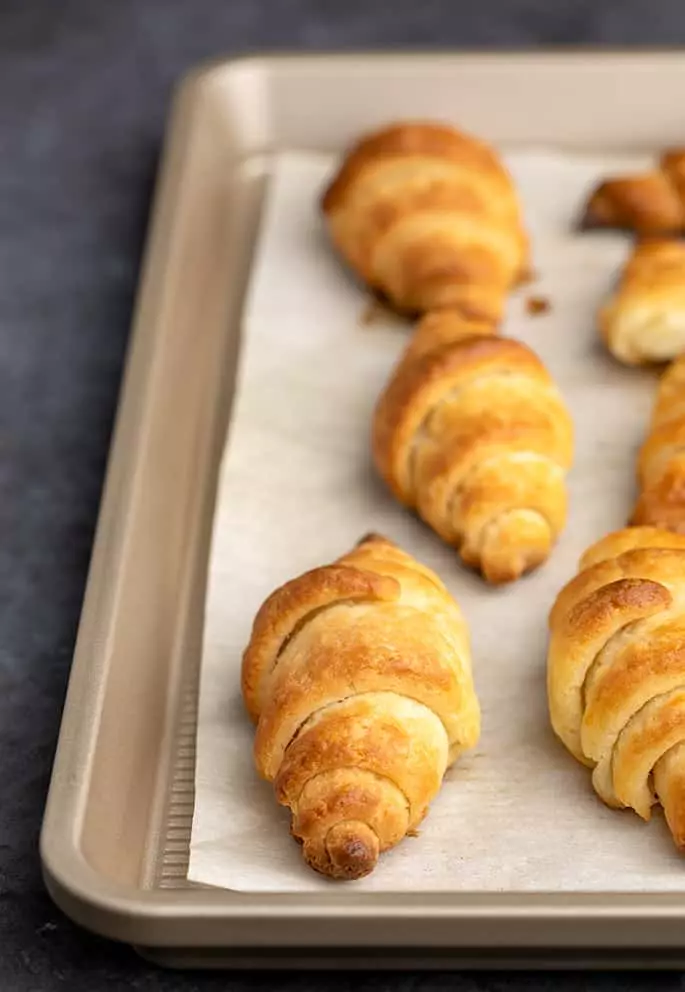
Gluten Free Croissant Recipe | Buttery, Flaky, and Simple!
Equipment
- Rolling Pin
- Pizza wheel or pastry wheel, for slicing/shaping
Ingredients
For the dough
- 2 ¼ cups (315 g) gluten free pastry flour or Cup4Cup gluten free flour, plus more for sprinkling (See Recipe Notes)
- 2 teaspoons (6 g) instant yeast
- 2 tablespoons (24 g) granulated sugar
- 1 teaspoon (6 g) kosher salt
- 3 tablespoons (42 g) unsalted butter melted and cooled
- ¾ cup (6 fluid ounces) whole milk at room temperature
For the butter packet
- 16 tablespoons (224 g) unsalted butter chilled
- ¼ cup (36 g) gluten free pastry flour or Cup4Cup gluten free flour (the “real” thing, or my mock Cup4Cup)
- Egg wash (1 egg + 1 tablespoon water, beaten well), for brushing
Instructions
Make the dough.
- In a large bowl, place the flour, yeast and sugar, and whisk to combine well. Add the salt, and whisk again to combine.
- Create a well in the center of the dry ingredients, add the butter and milk, and mix until the dough comes together.
- Add more flour by the half-teaspoonful if necessary to bring the dough together.
- Turn out the dough onto a lightly floured surface, sprinkle the top very lightly with more flour, and roll into a 9-inch round.
- Wrap tightly in plastic wrap and place in the refrigerator to chill while you prepare the butter packet.
Prepare the butter packet.
- Sprinkle a piece of unbleached parchment paper with 1/8 cup (2 tablespoons) of the flour, and place all 16 tablespoons (preferably in 2 whole sticks) of butter on top and press together.
- Sprinkle with the remaining 2 tablespoons of flour, and cover with another piece of unbleached parchment paper.
- Pound the butter with a rolling pin until it flattens and melds together.
- Uncover and fold the flattened butter in half, cover again with the parchment and pound again until you have a 5-inch square butter packet.
- Cover the butter packet completely with parchment, and place in the refrigerator to chill for 5 minutes or until firm.
Wrap the dough around the butter packet.
- Remove the 9-inch round dough from the refrigerator, unwrap it, and place it on a lightly floured surface.
- Place the chilled butter packet directly in the center of the dough and score the sides of the dough lightly to represent the exact size of the butter. Remove the butter and set it aside.
- Using a rolling pin and sprinkling the dough lightly with flour as necessary to prevent it from sticking, begin at the site of each of the four scorings and roll the edges of the dough away from the center to create 4 flaps, leaving the center of the dough intact.
- Return the butter packet to the intact center of the dough, and wrap the flaps of the dough around the butter packet like you would a present.
Roll out the dough with the butter and complete the first “turn.”
- Sprinkle the dough-and-butter-packet lightly with more flour, and roll out into a 1/2-inch thick rectangle.
- Fold the rectangle over on itself in thirds, as you would a business letter. Sprinkle the dough again lightly with flour.
- With the length of the 3-layer rectangle of dough running parallel to your body, roll the dough away from you into a rectangle that is again about 1/2-inch thick.
- Turn the left and right sides of the 1/2-inch thick rectangle over on themselves again, as you would a business letter.
- You have just completed the first “turn.” Wrap the folded dough tightly in plastic wrap and place in the refrigerator to chill for at least 4 hours or up to overnight.
Complete the remaining 4 to 5 “turns.”
- Once the dough has finished chilling after its first turn, repeat the process of rolling the 3-layer dough out into a 1/2-inch thick rectangle, then refolding the dough like a business letter, at least 4 more times, (for good measure, 5 more times). After each turn, keep track by pressing a notch in the dough with one knuckle to represent the number turn you're on (e.g., after 4 turns, make 4 notches).
- Be sure to wrap and chill the 3-layer rectangle of dough in the refrigerator for at least 30 minutes (or the freezer for 10 minutes) in between turns. If you let the dough chill for too long, it may become difficult to roll out smoothly. Just let it sit at room temperature for a few minutes before rolling it back out.
Shape the croissants.
- Line rimmed baking sheets with unbleached parchment paper and set them aside.
- Roll out the prepared 3-layer croissant dough into a 1/4-inch thick rectangle.
- Using a pastry wheel or pizza wheel (or very sharp knife—well-defined edges are essential here), square the edges, then cut out as many 4-inch x 6-inch rectangles as you can.
- Slice each rectangle diagonally into two triangles and separate the shapes from one another.
- Sprinkling lightly with flour as necessary to prevent sticking, roll each triangle out to elongate it to about 8-inches from base to tip.
- Slice a notch into the base of each triangle about 1/2-inch deep, and roll each triangle into a coil from base to tip, turning the edges slightly away from each other as you roll.
- Place on the prepared baking sheets, seam side down, about 2-inches apart from one another.
Proof the croissants.
- Cover lightly with oiled plastic wrap and place in a warm, draft-free location until nearly doubled in size. You will see the individual layers in each fold begin to separate slightly from one another once the croissants are fully proofed.
- Uncover the baking sheets and brush the tops and sides of the croissants with the egg wash.
- To avoid gluing the coiled layers of each croissant together, brush with the egg wash by beginning in the center of each pastry and brushing out to the sides in one motion on each side, with the “grain” of each coil, not against.
Chill the proofed croissants.
- Place the shaped and proofed croissants in the refrigerator to chill for at least 10 minutes or until mostly firm.
Bake the croissants.
- While the shaped croissants are chilling, preheat your oven to 400°F.
- Place the chilled and proofed croissants in the center of the preheated oven, one baking sheet at a time, and bake for about 20 minutes, or until deep golden brown all over and firm to the touch.
- Allow to cool briefly before serving.
Notes
- 80% all purpose gluten free flour blend (with xanthan gum), by weight (in one cup or 140 grams, 80% is 112 grams)
- 10% cornstarch, by weight (in cup or 140 grams, 10% is 14 grams)
- 10% milk powder, by weight (in cup or 140 grams, 10% is 14 grams)
- 280 grams all purpose gluten free flour blend (with xanthan gum*)
- 28 grams cornstarch
- 28 grams milk powder
WANT TO SAVE THIS RECIPE?

Thanks for stopping by!
Hi, I’m Nicole. I create gluten free recipes that really work and taste as good as you remember. No more making separate meals when someone is GF, or buying packaged foods that aren’t good enough to justify the price. At Gluten Free on a Shoestring, “good, for gluten free” just isn’t good enough! Come visit my bio!

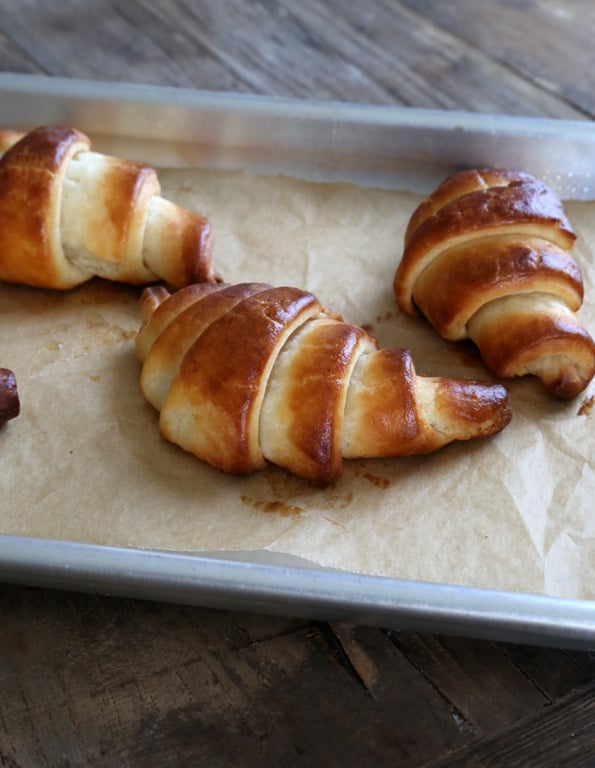

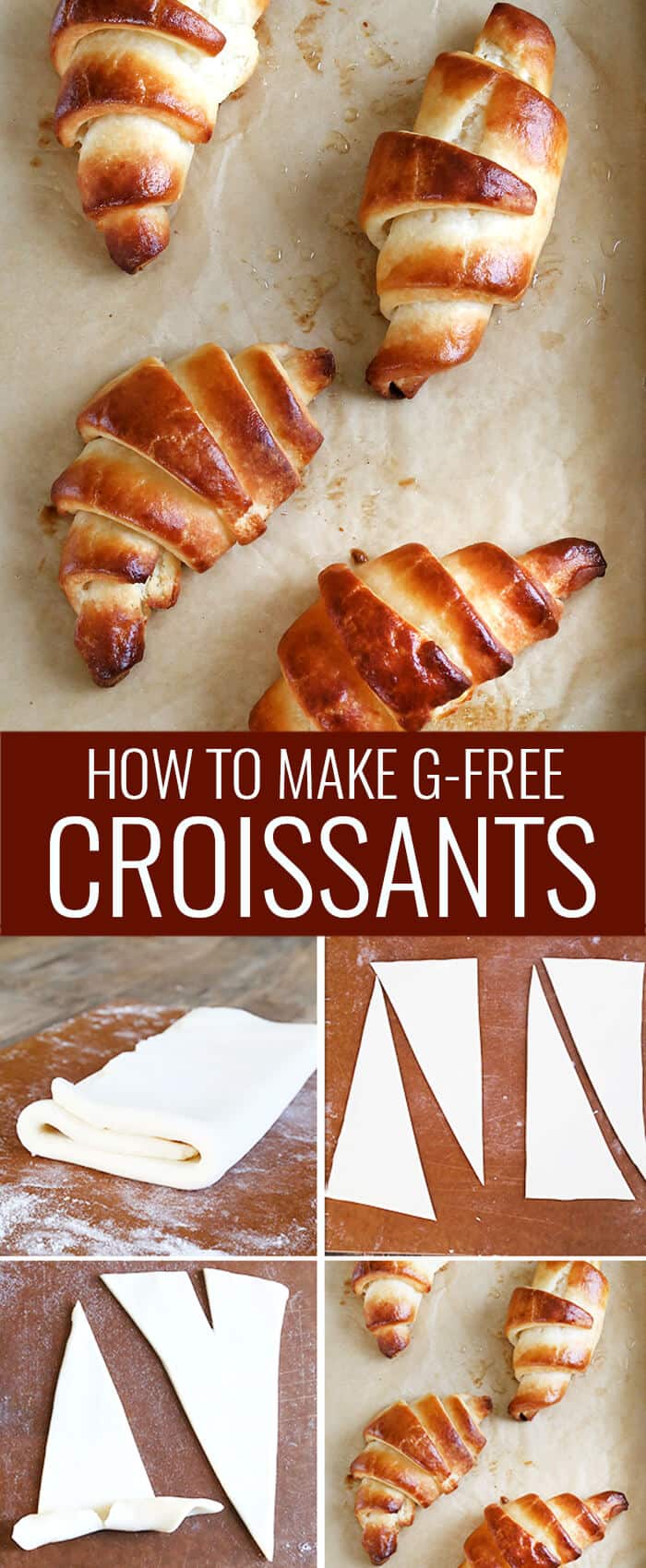

Shelly says
Can your freeze these and bake another day?
Nicole Hunn says
Since they’re yeasted, I don’t recommend that, I’m afraid. You can definitely make and shape non-yeasted pastry dough like biscuits ahead of time, but these may not rise properly after you freeze them.
Ella says
Measured by weight, paid attention to temps, used Cup4Cup. Dough never came together and was crumbly from the start so made it near impossible to roll out, but persisted. Did not rise and baked up as hard crumbly rocks.
Nicole Hunn says
My guess is that your butter was not in large enough pieces or kept cold enough, Ella. I’d also wonder if you measured by volume, or by weight, as it sounds like perhaps you overmeasured your flour.
Samantha says
I’m very excited to try this as every recipe of yours turns out amazing! I do have a question though. Could I substitute the corn starch with arrowroot or something else? We have a corn allergy in the household.
Nicole Hunn says
You can try using potato starch or arrowroot in place of cornstarch, Samantha. I haven’t tried that, so I can’t promise results, but it should work!
Cristie says
Sadly my own fault but I was so worried about over-proofing that I don’t think I let them rise for long enough before baking so didn’t quite get all my layers.
But I am very impressed with the flavour and texture and I’ll definitely be trying these again.
Worth noting that where the prolog states you need time for these, you need time! Plan your entire weekend around making them😂
Mariana says
I have not tried the recipe yet, but I want to ask: Can I use your GF Flour? If so, how much (if any) Xantar Gum should I add? Thank you in advance!
(I was looking for a GF Pasta Fresca recipe, and this is how I came to your website. I can’t wait to try many of the recipes here!
Nicole Hunn says
Hi, Mariana, Yes, you can use Nicole’s Best flour anywhere in any recipe that calls for an all purpose gluten free flour blend, but here the best blend is an all purpose gluten free flour blend plus cornstarch and milk powder, to make pastry flour.
There’s a little math involved here, but if you’re willing I’m happy to talk you through it. You’d have to use Nicole’s Best to build the gluten free pastry flour blend, which is 80% AP GF flour blend, 10% cornstarch and 10% milk powder, by weight. Full instructions for how to make pastry flour are on that page of the blog, linked in this recipe.
To make pastry flour, 80% of the total weight of the flour blend (a total of 350 grams here, for both the dough and the butter packet), is your AP GF flour. Here, 80% of 350 is 280 grams, or 2 cups. To make pastry, you need a heaping 1/2 teaspoon of xanthan gum per cup of Nicole’s Best. For 2 cups of flour, you’ll need a rounded or heaping 1 teaspoon of xanthan gum. To that, you’ll then add 10% of the total 350 grams (or 35 grams) cornstarch and 10% of the total 350 grams (or 35 grams) milk powder. The total is 350 grams.
The “Nicole’s Best Usage Guide” that is on every page of the sales website where you bought the flour guides how much xanthan gum you use. In the future, we are going to be including that chart in the box of flour that is sent to you so you have a physical copy.
Cristie says
Once proofed, can you leave them to have their final chill over night and bake them the next morning?
Thanks 😊
Nicole Hunn says
I don’t recommend leaving shaped yeasted bread to proof overnight, no, Cristie. It will rise too much and end up losing its shape.
Nicole says
Followed this recipe to the T, made the flour by weight. It was super wet and had to add flower to make it turn into a dough. The dough ended up super crumbly and wasn’t folding. Didn’t rise at all. No clue what’s going on.
Nicole Hunn says
From what you shared, Nicole, I suspect it’s your flour blend. It also sounds like maybe your butter was too warm/soft, which made the dough wet. You then added more flour, which made it crumbly. This is a very precise recipe and as I discuss in the post, temperature is everything.
CATHERINE MACKIEWICZ says
These were a labor of love but oh so worth the wait for my celiac daughter and I! We spread some with 2 tsp almond paste before rolling up (Id probably use 1 tablespoon next time) and others with ham and gruyere cheese. We cant decide which one we like best. They were both divine!
We used 2% lactose free milk (because it was all we had) and your pastry flour recipe. We accidentally put in the entire flour blend in the beginning vs adding a bit at a time and had some cracking on the edges as we folded it. We added a bit more milk and it all came together in the end. Thanks for the recipe!
Nicole Hunn says
I’m so glad you loved them, Catherine! They really sound delicious. Well done!
Crys Harris says
I’m using Cup4Cup and I’ve made croissants with wheat flour a couple of times and puffed pastry more times than that, so I’m no novice.
This recipe is not working out for me. I’m on turn two and the dough is not supple or foldable. Despite the butter and dough being the same temperature, butter started appearing at the cracked sides and is now throughout. I was suspicious when I brought the dough together and it wasn’t smooth. Reading through comments, I opted to add 1T water to the dough to increase moisture. The dough is quite dry at o 56% hydration.
I even rested the dough immediately after adding the butter packet because the dough wouldn’t stretch around the packet and cracked at the edges.
Right now, I’m pressing on because what else do you do? But I’m sure all the butter is going to run as soon as it gets into the oven. I can’t see any remedy. For me, the dough is just not workable. Maybe hydration up to 65-70% might work better.
Nicole Hunn says
Gluten free baking is quite different, and it often takes a few turns for the butter to be properly encased in the dough, Crys. Adding water would only serve to make the dough softer, which isn’t what you want. You didn’t mention if you made any ingredient substitutions and whether you measured by volume, not weight. It sounds like you may have undermeasured your flour, and adding water didn’t help. A hydration ratio of around 50% is standard in croissant dough, actually. It also sounds like you didn’t complete the 4-5 turns that are necessary to later and smooth the dough. Beyond that, there are many variables and although everyone believes they’ve followed a recipe precisely, that’s rarely the case. I’m afraid I don’t know where else you may have deviated from the recipe as written. Good luck.
KC says
Hi Nicole. I haven’t tried these yet, but I was wondering whether you have any experience using Dove GF plain flour from the UK? The ingredients are the same as your homemade flour blend, though I don’t know in what proportions. I don’t live in the US and can’t get Cup4Cup.
Nicole Hunn says
I have tried their flour, yes, KC, and I’m afraid I don’t like working with it at all. I would recommend your using one of my all purpose gluten free flour blend recipes with the individual ingredients and making your own blend.
Kelli says
Thanks – I’ll try that.
Mary Tholen says
Hello,
I love many of your recipes and respect your expertise. I have noticed that many of my favorite recipes have corn starch. Corn starch is almost identical to wheat and does have almost as much gluten. Do you think I could sub in potato starch for corn starch?
Nicole Hunn says
Corn is conclusively gluten free, Mary. That simply is not true. You can try using potato starch or arrowroot instead of cornstarch but I can’t promise results.
Michele says
I’ve made these twice and they aren’t working. What am I doing wrong?
The first time, I used the wrong kind of yeast, so I chalked it up to that.
The second time, I followed the directions exactly. My dough ends up being crumbly and just falls apart. I am using gluten free all purpose baking flour in the exact amount required. I bake often and am very experienced, but these just aren’t working for me. Any suggestions on how I can get my dough to combine better?
Nicole Hunn says
I’m afraid I really can’t know where you’re deviating from the recipe as written, but this recipe specifically calls for my gluten free pastry flour blend, so if you’re not using that with its exact component parts, measured by weight, you won’t be successful.
Herman Sutter says
Dough does not come together with 3/4 cup milk. Mine was crumbly and needed more moisture. But then it fell apart as I rolled it out. And fell apart again as I tried to add the butter packet. Much to dry using King Arthur Measure for Measure flour. I just put the folded dough/butter packet in refrigerator (after first turn). It may end up tasting good–I hope. But I am a little concerned for the appearance part.
Nicole Hunn says
Herman, you simply can’t use King Arthur’s flour blends to make my recipes, particularly anything with yeast. Please click the link in this recipe and in all recipes that call for an all purpose gluten free flour blend for a full explanation. This recipe in particular calls for my gluten free pastry flour blend. Flour blends matter significantly in my recipes, and in all gluten free recipes of higher quality. I’m afraid you can’t make my recipes without the precise ingredients specified. There are other bloggers who make recipes that are just okay, but that isn’t my aim.
Danielle says
Love the way these taste! I made an almond paste with mine and they are delicious! However, they came out pretty flat and lost their shape. They still pull apart like a croissant and the layers are there if you play with the inside a little. I’m not sure why they didn’t rise because they doubled in size when proofed but then collapsed when baking. I also had trouble during the folding process with my dough breaking whenever I tried to fold it in on itself. It wouldn’t crack at another other point except when trying to fold it. Any advice for next time would be greatly appreciated because they do taste really good!
Nicole Hunn says
It sounds like you overproofed them, Danielle, but of course I can’t be sure. There are many reasons that your dough might crack, since this is a complex recipe that requires a bunch of different techniques, ingredients, and temperatures. If you made any substitutions, particularly with respect to the flour blend (a high starch blend that isn’t properly balanced with make for a too-dry dough), didn’t measure by weight, or didn’t follow temperature directions. The almond paste, especially if homemade, would introduce unwanted moisture as well.